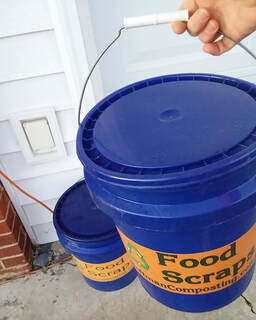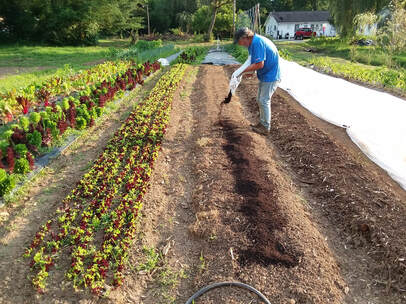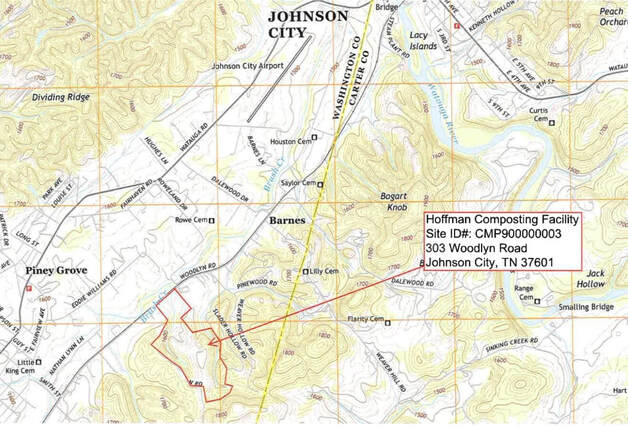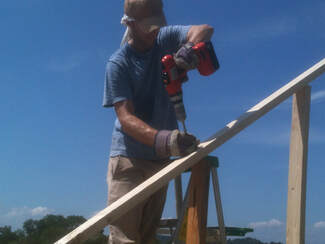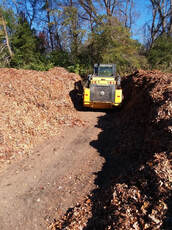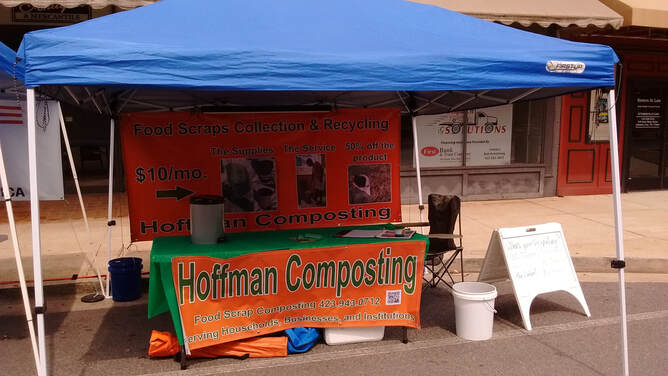|
Read below or click this link to download this guide for free:
|
| ||||||
Follow these 7 steps to start your compost business:
- Research your markets
- Get to know the regulations
- Select an appropriate site for your facility
- Secure funding
- Get your facility ready
- Promote to Your Markets and Community
- Launch
Step 1: Research Your Markets
|
Before you take on the risks and sacrifices to start your compost business, you had better make sure that the markets exist. Think in terms of inbound and outbound markets. More on inbound vs. outbound revenue streams here. Inbound markets are those residents, businesses (coffeeshops, juice bars, restaurants, organic waste haulers), and institutions that will pay you to take their food scraps. If you collect the scraps, the inbound revenue will be collection fees. If they are going to bring them to you, the inbound revenue will be tipping fees. Outbound markets are the people and businesses that will buy your finished products. Early on, your markets are home gardeners and small-scale local farmers. If you grow significantly, you can expand to landscapers, larger-scale farmers, and institutions. More on your outbound products here. More on compost business market research here. |
Step 2: Get to Know the Regulations
Make contact with your state’s environmental protection department. This will be the same agency (solid waste) that regulates and inspects landfills. For me, it’s the Tennessee Department of Environment and Conservation (TDEC). Your relationship with your state’s department of environmental protection will be very important. At times it may be frustrating, but the mission of your business will go with their waste diversion goals, and they will want you to succeed. Remember that they see lots of disasters and just want to make sure that your facility won’t be another one.
You may also need to satisfy local regulations. Contact local zoning and planning offices early in the process.
Step 3: Select an Appropriate Site for Your Facility
Your site selection will be impacted by regulations, proximity to markets, etc. To get started, find out what buffers are in the regulations and use GoogleEarth and a property viewer to look for properties that fit the bill. (My go-to site is the Tennessee Property Viewer.) Go visit the properties to make sure that they have potential. Then, contact the owners of any that are for sale or unused. I purchased the property that I built my facility on. You may opt for leasing or some other arrangement.
Before you commit to a particular property, have some field agents from your regulatory agency meet you there. Go over your general plan and make sure they agree that it will meet regulatory requirements.
I evaluated quite a few potential properties and met with their owners. The property that I bought was owned by General Shale. It wasn’t for sale, but they hadn’t used it in decades. I approached them and they agreed to sell it.
Read more about compost facility site selection here.
Before you commit to a particular property, have some field agents from your regulatory agency meet you there. Go over your general plan and make sure they agree that it will meet regulatory requirements.
I evaluated quite a few potential properties and met with their owners. The property that I bought was owned by General Shale. It wasn’t for sale, but they hadn’t used it in decades. I approached them and they agreed to sell it.
Read more about compost facility site selection here.
Step 4: Secure funding
Now that you have become an expert on your regulatory obligations and have a suitable site in mind for your facility, you must create as detailed a business plan as possible. Your start-up costs (site acquisition and preparation, equipment purchases, etc.) are only part of what you’ll need money for. No matter how much enthusiasm your markets profess, it will take a few years to build up the necessary clientele. In the meantime, you’ll need enough financial backing to keep the business running and to keep yourself alive.
There are many potential sources of funding – loans, investors, etc. I bought the property my site is on with a mortgage loan from a credit union. Then, I funded the preparation of the site and equipment (see next step) with a Home Equity Line Of Credit (HELOC). The benefit of doing it that way was that I retained 100% ownership in the business. The downsides are that the debt payments have been a big drag on my progress, the stress of literally betting the house on this has been significant, and the business started (and continues to function) with a very limited amount of capital.
There are many potential sources of funding – loans, investors, etc. I bought the property my site is on with a mortgage loan from a credit union. Then, I funded the preparation of the site and equipment (see next step) with a Home Equity Line Of Credit (HELOC). The benefit of doing it that way was that I retained 100% ownership in the business. The downsides are that the debt payments have been a big drag on my progress, the stress of literally betting the house on this has been significant, and the business started (and continues to function) with a very limited amount of capital.
Step 5: Get Your Facility Ready
It’s time to take the plunge and start the race to open your compost business! From the moment you buy your property and begin its preparations, a lot of money will be going out the door. You won’t be bringing money in until you get your facility up and running. Don’t cut corners on this step, but you don’t want it to drag out any longer than necessary.
Facility preparation will consist of four overlapping tasks: obtaining your permit, site preparation, equipment acquisition, and stockpiling of bulking agent and high carbon feedstocks.
Your Permit
By this point, you should already have had a fair amount of contact with your regulating agency and done your homework on the regulations themselves. As soon as you sign a contract on your property, you should begin the permitting process in earnest. This process will take months, if not a year. It will involve some back-and-forth with your regulatory agency that will impact your site preparation. It will also include a public notice period.
Facility preparation will consist of four overlapping tasks: obtaining your permit, site preparation, equipment acquisition, and stockpiling of bulking agent and high carbon feedstocks.
Your Permit
By this point, you should already have had a fair amount of contact with your regulating agency and done your homework on the regulations themselves. As soon as you sign a contract on your property, you should begin the permitting process in earnest. This process will take months, if not a year. It will involve some back-and-forth with your regulatory agency that will impact your site preparation. It will also include a public notice period.
|
Site Preparation
Site preparation is the construction task. It will consist of grading, surface preparation, fencing, structure construction, etc. This part is very expensive. The more of this that you can do yourself, the cheaper. But remember, you want it done right and in a reasonable amount of time. Sometimes, you’ll just have to pay someone to do something. More about site preparation here. |
Equipment Acquisition
Before you start your operation, you’ll also need to have your equipment in place. That’ll probably be explicitly stated in the regulations. Of course, equipment will be expensive, too. You’ll probably need to buy used. It’s risky, but workable equipment is out there. You can get a good deal if you’re thorough and unhurried. Check local classifieds like the Thrifty Nickel, FaceBook Market, Craigslist, eBay, EquipmentTrader, GovDeals.com, etc. Of course, if you or your friends have or know folks with underused equipment, all the better. I got my Bobcat from a retiring excavator a few hours away. More about equipment here.
Before you start your operation, you’ll also need to have your equipment in place. That’ll probably be explicitly stated in the regulations. Of course, equipment will be expensive, too. You’ll probably need to buy used. It’s risky, but workable equipment is out there. You can get a good deal if you’re thorough and unhurried. Check local classifieds like the Thrifty Nickel, FaceBook Market, Craigslist, eBay, EquipmentTrader, GovDeals.com, etc. Of course, if you or your friends have or know folks with underused equipment, all the better. I got my Bobcat from a retiring excavator a few hours away. More about equipment here.
Step 6: Promote to Your Markets and Community
Once you have a rough launch window, you should start promoting your facility as an economical disposal option and as a source of compost. Don’t wait for the previous step to be finished before you knock on doors and line up customers.
If social media isn’t your thing, you need to develop at least a basic competence in FaceBook and Instagram. I am not great about consistent posts, but those platforms are a cost-effective way to spread the word. Over time, familiarize yourself with different kinds of posts, stories, and ads. Other platforms like Pinterest and NextDoor are also worth exploring.
Another way to reach people is to present at meetings of civic groups – Kiwanis, Rotary, etc. are fine, but gardening clubs are much better. You’ll be surprised how many gardening clubs are around. They’re very knowledgeable about compost’s benefits and the process of composting. They often produce their own, but need much more.
If social media isn’t your thing, you need to develop at least a basic competence in FaceBook and Instagram. I am not great about consistent posts, but those platforms are a cost-effective way to spread the word. Over time, familiarize yourself with different kinds of posts, stories, and ads. Other platforms like Pinterest and NextDoor are also worth exploring.
Another way to reach people is to present at meetings of civic groups – Kiwanis, Rotary, etc. are fine, but gardening clubs are much better. You’ll be surprised how many gardening clubs are around. They’re very knowledgeable about compost’s benefits and the process of composting. They often produce their own, but need much more.
As you promote, be it to groups or online, try to get as much contact information as possible so you can reach out to them when you start your compost business.
Don’t waste your money on print advertising or radio. I’ve spent a few thousand bucks on those efforts with no return. Same for direct mailers. Also, I’ve had very little response from taping flyers on front doors, and it’s super time consuming.
Don’t waste your money on print advertising or radio. I’ve spent a few thousand bucks on those efforts with no return. Same for direct mailers. Also, I’ve had very little response from taping flyers on front doors, and it’s super time consuming.
Step 7: Launch
Finally! Your facility is ready and you are permitted to operate. To start your compost business, contact directly all the individuals, businesses, and institutions that expressed interest in your services and products. Get them to sign up for your service. Also, use social media to make sure that everyone knows that you’re open. Explicitly ask everyone to share your post and help spread the word.
Continue promoting to new people, work out the kinks, and, above all, satisfy your customers.
Continue promoting to new people, work out the kinks, and, above all, satisfy your customers.
